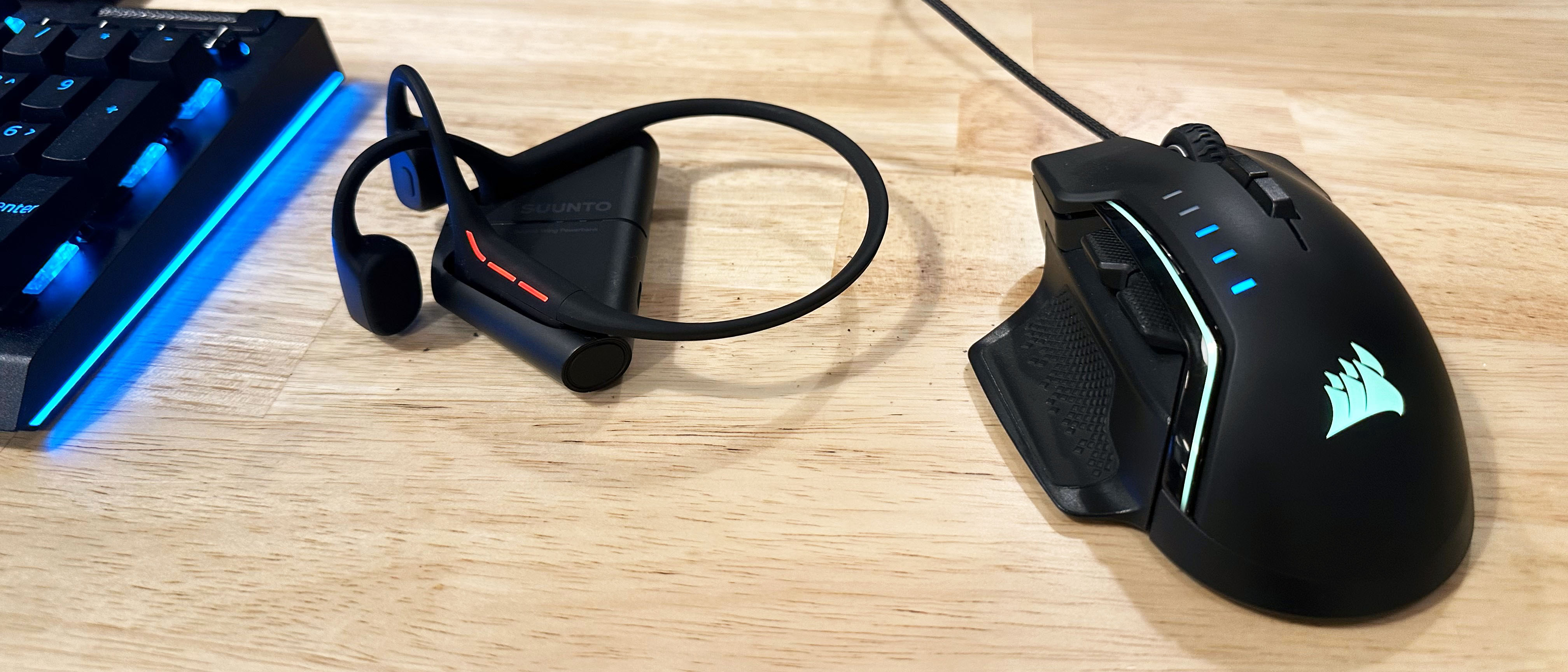Laptop Mag Verdict
The Suunto Wing open-ear bone conduction headset provides decent enough audio to keep you zoned in without cutting you off from the outside world.
Pros
- +
Open-ear design
- +
Head gesture controls
- +
Optional LED lights for visibility
- +
IP67 rating
- +
Long battery life
Cons
- -
Headstrap does not adjust
- -
Needs a companion app
- -
Audio quality is subpar
Why you can trust Laptop Mag
The Suunto Wing headphones are designed to keep you connected while you venture out into the wild. From its open-ear design to its water resistance rating and optional LED lights, every aspect of the Wing is intended to support an active lifestyle.
While you can use these bone conduction headphones at home or at the office, they will pale in performance compared to the studio headsets. But the Suunto Wing headphones do have a long battery life, and the open-ear design keeps you tuned in to office gossip while your work playlist runs in the background.
As a pair of active headphones, the Suunto Wing can take almost everything you throw at it. But is that enough to make it onto our best wireless headphones list?
Suunto Wing: Pricing and availability
The Suunto Wing is available for $199 from Suunto in black or a black and red color scheme. There are no configuration options for the Wing, but you can find it on sale at Amazon for $169 at the time of writing.
The Wing is an updated version of the Suunto Sonic, which is still available from Suunto for $149. The Sonic does not feature the optional LED lights and has a lower IP55 water resistance rating.
Suunto Wing: Design

The Suunto Wing is an open-ear headset, so the design is a little bit funky. The Wing is not the first set of open-ear headphones to hit the streets, but they’re new enough to look almost wrong. The Wing, much like the Suunto Sonic before it, is a minimalist pair of headphones with a small form factor. The Wing comes with an increased water resistance rating and optional LED lights along the sides of the headset for extra visibility at night, which makes it a solid update from the Suunto Sonic.
While the Wing does boast an IP67 water resistance rating, that just means it can survive a dip into 3 feet of water for up to 30 minutes. Which is alright for a short swim, but these are definitely not headphones designed for swimmers in mind. They’re more ideal for a kayaking or fishing trip where you may get occasionally splashed.
Sign up to receive The Snapshot, a free special dispatch from Laptop Mag, in your inbox.
You do get some basic hands-free head gesture controls with the Suunto Wing. To use them, however, you need to download the Suunto App, connect the Wing, and then enable head gesture controls. Otherwise, you are limited to picking up or skipping calls, and skipping to the next music track using nods and head shakes. But these are pretty convenient features to have. It's just a shame they require the Suunto App. The optional LED lights also require the app, which allows you to set it to ‘constant light,’ ‘flashing,’ or ‘SOS.’
The Wing is lightweight and comfortable, though the head strap can’t be adjusted which makes it a tricky fit if you have a larger head or thick hair. Having quite a lot of hair that is on the thick side, I have to wear my hair in a high ponytail or a very low tail in order to get the Wing to fit correctly. If I go with my default french braid, the Wing struggles to fit on my jawbone correctly.
Obviously for most, the Wing will fit just fine. I have found workable hairstyles that keep my hair out of my face without disturbing the headphones. But it is something of an annoyance, particularly with sports that require helmets. I generally braid my hair back for those, but that won’t work well if I’m also trying to use the Suunto Wing for my epic soundtrack at the same time.
Suunto Wing: Audio performance

Open-ear bone conduction headphones are always going to fall a bit short when compared to over-ear studio quality headphones like the Audio-Technica ATH-M50xBT2, which won our hearts two years ago. That’s just a limitation of the technology and form factor.
The trade-off to having the safety of an open-ear design is that bone conduction sound does lose a bit of quality. So while you can still stay aware of your surroundings with the Wing, you do give up sound quality, details like key changes or dyads. Songs may sound a little more muffled with the bone-conduction style than you’re used to from in-ear or over-ear headphones.
That said, when fighting through white water rapids on a single-person kayak, you won’t notice the small degradation in audio quality. After all, you wouldn’t be taking over-ear studio headphones on a hike.
The Wing does have premium quality bass, however, because of their nature as bone conduction headphones. You do get some head rumble out of it when you push the bass limits on the Wing. A negative experience if you don’t like feeling your brain wobble to Dream Theater’s Panic Attack. I think it's a nice feature, but I do realize my standards here are very much a matter of preference.
The Wing defaults to a ‘normal’ or balanced sound mode, which is suitable for most daily environments. With the use of the Suunto App, you can also access the enhanced ‘Outdoor’ sound mode which increases the volume ceiling of the headphones. This is ideal for outdoor or noisy environments. You will only notice a change with the headphones set to their maximum volume. There is a bit of noise bleed to those around you when set on ‘Outdoor’ mode, but for ‘normal’ there really isn’t much noticeable noise coming from the headphones even at their loudest setting.
Suunto Wing: Battery life

Suunto claims the Wing has up to 10 hours of battery life, with an additional 20 hours stored in the power bank. There are some caveats to the battery life claims, however. With head movement controls, the battery life drops from 10 hours to 8 hours. And if you turn the LED lights on to “constant” then the battery life dips down to 4 hours or less. So you do suffer a bit for those extra safety features.
While we don’t have a version of our laptop battery test for headphones, in my own hands-on testing of the Wing I did get the headset to keep up with my work day and still have battery left for the commute home. I don’t generally go for bike rides over a few hours, and I certainly don’t go for marathon runs on the weekends. But I can confirm Suunto’s claim of up to 10 hours of battery life.
Bottom line
You can’t expect perfect sound quality from open-ear sports headphones. It’s just not going to happen with the technology we have. That said, the Suunto Wing does a remarkable job of providing quality sound despite being a bone conduction headset. It’s designed specifically for outdoor sports and that is going to be the best use of the Wing.
Sure, you can use them as your daily headphones if you need. But you are better off with over-ear or earbuds for most tasks. Unless you really love the feeling of getting your brains rattled at live music shows. In which case the Suunto Wing can mimic the experience.
Overall, if you want sport headphones to go with you into the most extreme situations and last up to 10 hours, the Suunto Wing is a fantastic choice.

A former lab gremlin for Tom's Guide, Laptop Mag, Tom's Hardware, and TechRadar; Madeline has escaped the labs to join Laptop Mag as a Staff Writer. With over a decade of experience writing about tech and gaming, she may actually know a thing or two. Sometimes. When she isn't writing about the latest laptops and AI software, Madeline likes to throw herself into the ocean as a PADI scuba diving instructor and underwater photography enthusiast.

